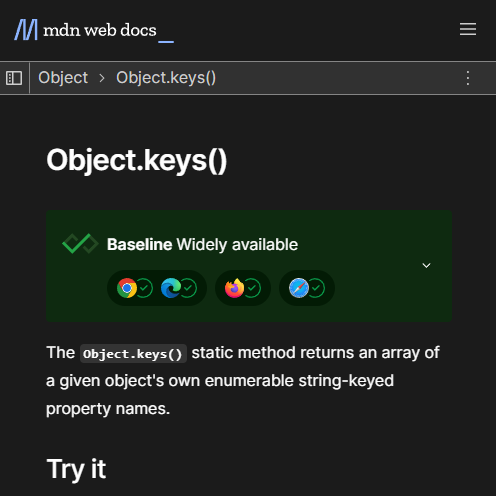Alright, let’s cut the crap and talk about object methods in JavaScript—the tools you need to manipulate objects like a boss. Here’s a no-nonsense rundown of the most commonly used ones, along with practical examples so you can stop wasting time and start coding smarter.
1. Object.keys() – Getting the Keys, No Excuses
When you need to iterate over an object’s properties, Object.keys() is your best friend. It returns an array of the object’s keys.
Example: Listing Object Properties
const user = {
name: 'John Doe',
age: 30,
role: 'Frontend Developer'
};
const keys = Object.keys(user);
console.log(keys); // ["name", "age", "role"]Usage:
Great for when you want to loop through an object’s properties and do something with each key.
2. Object.values() – Getting the Damn Values
Sometimes you’re not interested in the keys—you just need the values. Object.values() returns an array of all the values in an object.
Example: Getting User Details
const user = {
name: 'John Doe',
age: 30,
role: 'Frontend Developer'
};
const values = Object.values(user);
console.log(values); // ["John Doe", 30, "Frontend Developer"]Usage:
Use it when you want to process or display just the values from your object.
3. Object.entries() – Keys and Values, Together at Last
Want both keys and values at the same time? Object.entries() returns an array of key-value pairs.
Example: Iterating Over an Object
const user = {
name: 'John Doe',
age: 30,
role: 'Frontend Developer'
};
Object.entries(user).forEach(([key, value]) => {
console.log(`${key}: ${value}`);
});
// Output:
// name: John Doe
// age: 30
// role: Frontend DeveloperUsage:
Perfect for when you need to work with both the property names and their values in one go.
4. Object.assign() – Merging Objects Without the BS
When you need to merge objects or clone them, Object.assign() is the tool to use.
Example: Merging Two Objects
const defaults = { theme: 'light', showSidebar: true };
const userSettings = { theme: 'dark' };
const finalSettings = Object.assign({}, defaults, userSettings);
console.log(finalSettings); // { theme: "dark", showSidebar: true }Usage:
It’s great for merging settings, creating shallow copies, or even updating objects without mutating the original. Just be aware that it only does a shallow copy.
5. Object.freeze() – Lock It Down, No More Bullshit Changes
Want to make sure your object isn’t changed by accident (or by some asshole in your code)? Use Object.freeze().
Example: Freezing an Object
const config = {
apiUrl: 'https://api.example.com',
timeout: 5000
};
Object.freeze(config);
config.timeout = 10000; // This change will fail silently (or throw an error in strict mode)
console.log(config.timeout); // 5000Usage:
It’s handy when you need to ensure that certain objects remain immutable throughout your program’s lifecycle.
6. Object.create() – Creating Objects the Old-School Way, Without the BS
Object.create() lets you create a new object with a specified prototype. It’s like cloning but with a twist.
Example: Creating an Object with a Prototype
const personProto = {
greet() {
console.log(`Hello, my name is ${this.name}`);
}
};
const person = Object.create(personProto);
person.name = 'John Doe';
person.greet(); // "Hello, my name is John Doe"Usage:
Use it when you need to create objects that inherit from a specific prototype—useful for building objects in a more controlled way than using constructors.
Final Thoughts
These object methods are essential tools in your JavaScript arsenal. They help you access, manipulate, merge, and secure your objects—all without any unnecessary fluff.
Object.keys(),Object.values(), andObject.entries(): Perfect for iterating over object properties.Object.assign(): The go-to for merging or cloning objects.Object.freeze(): For when you need to lock an object down.Object.create(): For creating new objects with a specified prototype.
Get your hands dirty—experiment, break things, fix them, and then do it all over again. That’s the only way to truly master this shit.
Happy coding, and go fuck those bugs away! 🚀🔥


Leave a Reply